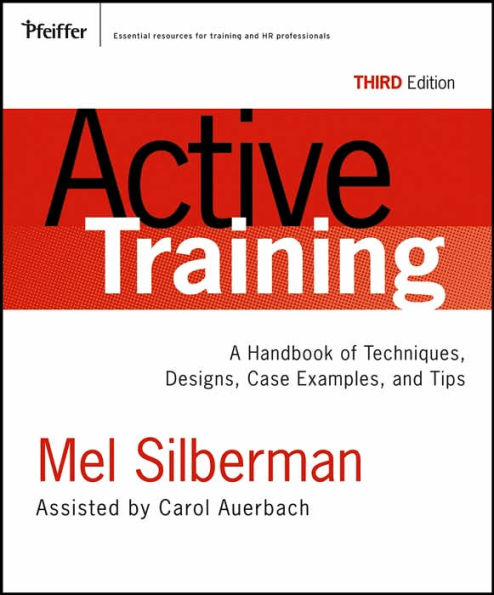Table of Contents
List of Figures.
Preface.
Acknowledgments.
PART ONE: INTRODUCING ACTIVE TRAINING.
The Nature of Adult Learning.
Concerns About Active Training.
The Delivery of Active Training.
PART TWO: DESIGNING AN ACTIVE TRAINING PROGRAM.
Chapter 1. Assessing Training Needs.
Why Do Assessment?
What Information Should Be Collected?
How Can Information Be Collected?
What If There Is No Time to Do a Proper Assessment?
Chapter 2. Developing Active Training Objectives.
Setting Learning Goals.
Selecting Objectives.
Specifying Objectives.
Expressing Objectives.
Communicating Training Objectives to Others.
Chapter 3. Creating Opening Exercises.
What Opening Exercises Accomplish.
What to Keep in Mind When Creating Opening Exercises.
Ten Ways to Obtain Participation.
Chapter 4. Preparing Brain-Friendly Lectures.
Five Ways to Gain Your Audience’s Interest.
Five Ways to Maximize Understanding and Retention.
Five Ways to Involve Participants During a Lecture.
Five Ways to Reinforce Lectures.
An Example of a Well-Designed Lecture.
Chapter 5. Finding Alternative Methods to Lecturing.
Demonstration.
Case Study.
Guided Teaching.
Group Inquiry.
Information Search.
Study Group.
Jigsaw Learning.
Tournament Learning.
Applying the Alternatives to a Common Topic.
Chapter 6. Using Experiential Learning Approaches.
Role Playing.
Games and Simulations.
Observation.
Mental Imagery.
Writing Tasks.
Action Learning.
Chapter 7. Designing Active Training Activities.
The Three Major Ingredients of Any Design.
Basic Questions About Any Design.
The Remaining Details.
Three Tips for Creative Designs.
Chapter 8. Sequencing Active Training Activities.
Basic Sequencing Guidelines.
Applying Sequencing Guidelines.
The Finer Side of Sequencing.
Experiential Learning Sequences.
Chapter 9. Planning Active Training Programs.
The Macrodesign of an Active Training Program.
Chapter 10. Blending Technology into Active Training.
Independent e-Learning.
Group-Based e-Learning.
Virtual Classrooms.
Blended Learning.
PART THREE: CONDUCTING AN ACTIVE TRAINING PROGRAM.
Chapter 11. Beginning an Active Training Program.
Preparing Yourself Mentally.
Arranging the Physical Environment.
Greeting Participants and Establishing Rapport.
Getting the Best from the First Thirty Minutes of Training.
Reviewing the Agenda.
Inviting Feedback to the Agenda.
Chapter 12. Gaining Leadership of the Training Group.
Setting Group Norms.
Controlling Timing and Pacing.
Getting the Group’s Attention.
Increasing Receptivity to Your Leadership.
Handling Problem Situations.
Chapter 13. Giving Presentations and Leading Discussions.
Knowing Your Group.
Organizing Your Presentation.
Watching Your Body Language.
Adding Visuals.
Making Smooth Transitions.
Facilitating a Lively Discussion.
Chapter 14. Facilitating Structured Activities and Promoting Team Learning.
Structured Activities.
Team Learning.
Chapter 15. Concluding an Active Training Program.
Reviewing Program Content.
Obtaining Final Questions and Concerns.
Promoting Self-Assessment.
Planning Next Steps.
Expressing Final Sentiments.
PART FOUR: EXTENDING THE VALUE OF AN ACTIVE TRAINING PROGRAM.
Chapter 16. Providing for Back-on-the-Job Application.
Prior to the Training Program.
During the Training Program.
At the End of the Training Program.
Follow-Up Coaching and Support.
Chapter 17. Evaluating an Active Training Program.
Interim Feedback.
Final Assessment.
Final Thoughts.
References.
Index.
About the Authors.
Pfeiffer Publications Guide.







